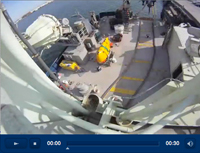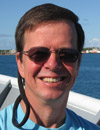
 Today's Weather
Today's Weather
Sunny
Latitude: 30 21' N
Longitude: 89 05' W
Air temp: 47.5 F (8.6 C)
Pressure 1023.12 bar
Wind: N, 13 mph
Visibility: unlimited
Seas: calm


Rapid Response Science
December 05, 2010 (posted December 6, 2010)
by Ken Kostel
Things don’t usually work this way. Research cruises generally take years to plan and organize. Just to get on the schedule to use Alvin usually takes two years. Sentry requires at least a one-year advance notice. Writing proposals to agencies to fund research and the nerve-wracking wait to hear back only add to that timeline.
But this cruise is different. It was on no one’s schedule six months ago. Two months ago Alvin became available. Sentry was added to the cruise plan less than a month ago. Two weeks ago an ocean bottom time-lapse camera became available and the expedition’s chief scientist, Chuck Fisher from Pennsylvania State University, decided to bring it along before he knew if researchers would have the money for it. They found it.
“We have to be flexible and take advantage of opportunities in what we do,” Fisher told me soon after he arrived on Atlantis. “But this is unheard of to have everything come together like this.”
The flurry of activity is largely the result of something called a RAPID response grant from the National Science Foundation (NSF). The NSF funds a large portion of the scientific research in the United States and, together with the Census of Marine Life, is funding this cruise. It set up the RAPID program specifically so that researchers could respond quickly to unanticipated events such as earthquakes and underwater eruptions—and in this case, an oil spill. That’s a big help to the scientists and crew on board Atlantis, but it also means that today everyone’s pressed for time.
Most of the science crew arrived in Gulfport today, and when they did, the energy level on deck and in the labs jumped. Even before they got here, though, the ship was humming with activity. The Sentry and Alvin crews were busy preparing their vehicles. Dan Fornari, a WHOI scientist who has had more than 100 dives on Alvin, was assembling his deep-sea time-lapse camera on one corner of the deck. The Atlantis crew members have given up some of their precious time ashore so that the ship can leave nearly a day early and were busy cleaning out the labs and preparing the ship for sea.
To top it all off, this is also going to be a short cruise, which means there is little margin for error. The cruise just before ours ran into bad weather out in the Gulf and had to cancel three Alvin dives. But they did nearly 20 dives. We have a total of only six.
All of this highlights the need for detailed planning and the flexibility to change those plans at the last minute. That is somewhat complicated by the fact that much of the information Chuck and the other scientists are using to select potential dive sites is still very new. In the beginning of November, a remarkably successful series of dives by the remotely operated vehicle (ROV) Jason visited many of the sites Chuck had picked for this cruise.
On its last dive, however, Jason found a patch of dead and dying coral near the Deepwater Horizon wellhead that spilled so much oil into the Gulf. That, said Chuck, pointed to the need for more exploration around the well, so he scrapped his plans and began looking for sites that would give him a better picture of how the oil might be affecting life in the deep ocean. Photographs from a deep-sea camera only came back last week to help the team create a short list of places they’d like to visit. Capt. Arthur “A.D.” Colburn has said Chuck can put off making a final decision on where to go first until we reach the sea buoy Monday night.
“This is the nature of rapid response,” said Chuck.
Who knows what Monday will bring? All I know is we leave at 4 p.m., so stay tuned.
Read the new interview

Chuck Fisher: Chuck Fisher, a biological oceanographer from Pennsylvania State University is the Chief Scientist on this expedition. Learn more about Chuck, and hear his perspective on why research in the Gulf of Mexico is so important, expecially now. Read the interview » [ Next update ]
[Back
to top] |




